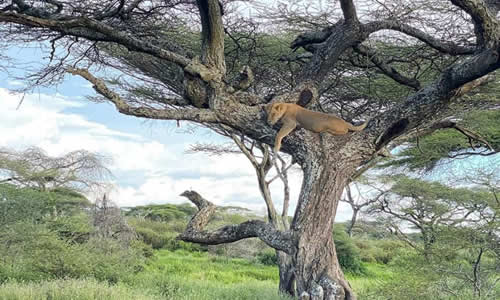 Masai Mara National Reserve is considered a "must see" for any new and repeat visitor traveling on a safari to Kenya. It is on the "to do" list for many Kenyans and visitors alike because the park is graced by a wide variety of unique and exquisite wildlife and birds. Masai Mara National Reserve is situated within the Great Rift Valley in the southern part of Kenya. Measuring approximately 1510sq. kilometres (approx. 938sq. miles) in size, this unfenced savannah grassland is roughly 150 miles southeast of Nairobi.
Masai Mara National Reserve is considered a "must see" for any new and repeat visitor traveling on a safari to Kenya. It is on the "to do" list for many Kenyans and visitors alike because the park is graced by a wide variety of unique and exquisite wildlife and birds. Masai Mara National Reserve is situated within the Great Rift Valley in the southern part of Kenya. Measuring approximately 1510sq. kilometres (approx. 938sq. miles) in size, this unfenced savannah grassland is roughly 150 miles southeast of Nairobi.
Maasai Mara derives its name from the indigenous people of Kenya - the Maasai tribe - and the Mara River that cuts through the park. The Masai Mara provides the best view of the famous wildebeest migration as the animals cross the Mara River between July and September. It is also home to the richest concentration of wildlife, including the "Big Five" (elephants, lions, leopards, rhinos, and buffalo), population of black rhinos is severely threatened with only 37 black rhinos left as of 2000.
Herds of plains zebras are found throughout the park, as well as Masai giraffes, common giraffes, jackals, white-bearded gnus, Oribis, warthogs, Thomson's and Grant's gazelles, hartebeests, hyenas, bat-eared foxes, rare Topi antelope and beautiful rone antelope, as well as hippos and crocodiles in the Mara River. The park has the largest concentration of African lions, including the black-maned lion. Birdlife is as plentiful as wildlife at the Masai Mara, which boasts over 400 different birds species. The park experiences a hot and dry climate with a regular rainfall season twice a year. The reserve's topography is mainly open savannah (grassland) with clusters of acacia trees along the southeastern area of the park. The Mara and Talek rivers grace the rolling plains of the reserve. Myriad seasonal rivers appear during the rainy season but dry out once the rains are gone.
Leylani Holidays for best affordable safaris in East Africa
Travel to Top destinations for tours and holidays
+254 103 394833
info@leylaniholidays.com
Leylani Holidays, your safari partner of choice
Our Partners and Connections




Copyright © 2025. Leylani Holidays. Powered By Bingwa Technologies

 Beautiful sceneries, beautiful wildlife
Beautiful sceneries, beautiful wildlife  Hundreds of holiday destinations and features to behold
Hundreds of holiday destinations and features to behold  The roaring king of the jungle
The roaring king of the jungle  The phenomenal eighth wonder of the world - the wildebeest migration
The phenomenal eighth wonder of the world - the wildebeest migration  Rhinos, black and white, can be found in Kenya and Tanzania
Rhinos, black and white, can be found in Kenya and Tanzania  Dine with the giraffes at Giraffe Manor
Dine with the giraffes at Giraffe Manor  We have flying safaris to different destinations
We have flying safaris to different destinations  Variety of camping safaris to select from
Variety of camping safaris to select from  The camps are clean, with all necessary facilities
The camps are clean, with all necessary facilities  0
0  1
1  2
2  3
3  4
4  5
5  6
6  7
7  8
8